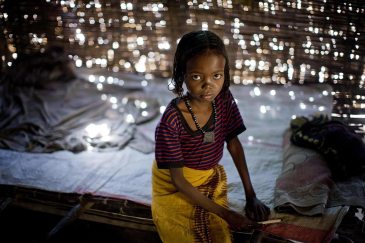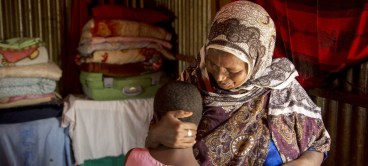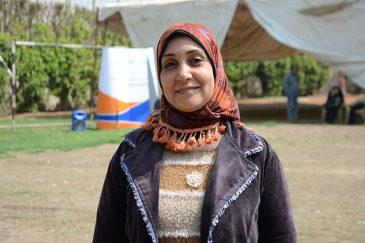Born Complete, Don’t Mutilate Them!
TRANSCEND MEMBERS, 1 Apr 2019
Baher Kamal | Human Wrongs Watch – TRANSCEND Media Service
30 March 2019 — While male circumcision is spread mainly among Muslim and Jews communities, and it is apparently accepted by some medical spheres, more than 200 million child-girls have already fallen prey to a dangerous practice, which is carried out in the name of traditions or even religions: Female Genital Mutilation (FGM).

Fatima, 7, sits on a bed in her home in Afar region, Ethiopia. She was subjected to FGM/C when she was 1 year old.
Photo: UNICEF/ Holt
Such a flagrant human rights violation is not legally typified as a “crime”. Furthermore, it is far from being stopped—in fact some 70 million more girls are right now at risk of being mutilated by the year 2030.
See what happens — Female Genital Mutilation is a “violent act” that, among other dramatic consequences, causes “infection, disease, childbirth complications and death,” said on this silenced practice the executive directors of the United Nations Population Fund (UNFPA) and UN Children’s Fund (UNICEF) in a joint statement for the International Day of Zero Tolerance for Female Genital Mutilation on 6 February 2019.
In order to denounce this violation, it should be more than enough to report some of the key facts and conclusions that world health and human rights experts have compiled for the United Nations Organization.

Female Genital Mutilation practitioner with her 10-year-old granddaughter in Diaami, Hargeisa in Somaliland. The young girl was supposed to have been cut already but she is sick with an infection so her grandmother is waiting.
UNFPA/Georgina Goodwin
Facts and conclusions that have been presented on the occasion of this year’s International Day of Zero Tolerance for Female Genital Mutilation: Female Genital Mutilation (FGM) comes in many forms, and has dire consequences for its victims:
- Clitoridectomy – partially or totally removal of the clitoris and/or prepuce.
- Excision – partially or totally removing the clitoris and the labia minora.
- Infibulation – narrowing the vaginal orifice by cutting and re-positioning the labia minora and/or the labia majora as a covering seal.
- Pricking, piercing, incising, scraping or cauterisation
- Female Genital Mutilation (FGM) – sometimes called female circumcision – involves the partial or total removal of the external female genitalia for no medical reason, and results in severe physical and mental health consequences for girls and women.
- Female Genital Mutilation is mostly carried out on young girls sometime between infancy and age 15, but it is in cases practiced on women aged nearly 50 years.
- If Female Genital Mutilation (FGM) persists at current levels, rapid population growth in countries where it is concentrated will significantly increase the number of girls subjected to it.
- Countries with the highest prevalence are Somalia at 98 per cent, Guinea at 97 per cent, Djibouti 93 per cent and Egypt at 87 per cent.
- Girls who undergo female genital mutilation face short-term complications like severe pain, shock, excessive bleeding, infections, and difficulty in passing urine, as well as long-term consequences for their sexual and reproductive health and mental health.
- About 80 per cent of women and girls who have undergone the procedure have had their clitoris and labia minora removed. Complications include severe pain, hemorrhaging, sepsis, urethra damage, painful sexual intercourse and other sexual dysfunction. Genital mutilation also has psychological repercussions, with many victims feeling anxious, depressed, incomplete and traumatised.
- Female genital mutilation is rooted in gender inequalities and power imbalances between men and women – and it sustains them by limiting opportunities for girls and women to realise their rights and full potential in terms of health, education and income.
- Female genital mutilation violates the human rights of women and girls, contravening established principles, norms and standards including non-discrimination on the basis of sex; the rights to health, physical integrity and life; the right to freedom from torture or cruel, inhuman or degrading treatment or punishment; and the rights of the child.
- In cultures that condone FGM, it is usually performed by a traditional practitioner with crude instruments and without anaesthetic. And every year, almost four million girls are at risk”.
In other words, Female Genital Mutilation comprises all procedures that involve “altering or injuring the female genitalia for non-medical reasons and is recognised internationally as a violation of the human rights of girls and women.”

Women leading the movement to end FGM | Magda Ahmed, a rural women leader from Minya during a volunteers camp in March 2018. Photo: UN Women/Ahmed Hindy
According to the UN, “this violent, harmful practice reflects deep-rooted inequality between the sexes, and constitutes an extreme form of discrimination against women and girls… The practice also violates their rights to sexual and reproductive health, security and physical integrity, their right to be free from torture and cruel, inhuman or degrading treatment, and their right to life when the procedure results in death.”
In addition to the fact that most of the girls and women who have been subject to FMG live in numerous African countries, and some in Asia, they are also increasingly found in Europe, Australia, Canada and the United States; primarily immigrants from Africa and southwestern Asia, according to a joint statement marking this year’s World Day from the UN Children’s Fund (UNICEF), UN Population Fund (UNFPA) and UN Women.
Also among Migrants and Refugees
The world body’s experts also report that, although primarily concentrated in some 30 countries in Africa and the Middle East, FGM is a universal problem and is also practiced in some States in Asia and Latin America. Moreover, FGM continues to persist amongst immigrant populations living in Western Europe, North America, Australia and New Zealand.
In July 2018, the Report Intensifying global efforts for the elimination of female genital mutilation stated that efforts to end these practices should also target the groups of women and girls who are most at risk, “in particular those who face multiple and intersecting forms of discrimination, including refugee and migrant women, women living in rural and remote communities and young girls, so as to leave no one behind.”
What else to say about such an act of cruelty…? Maybe to reiterate that it is in many cases committed in the name of religious beliefs, whose self-proclaimed male representatives use to justify it by saying that mutilating girls is the way to “purify” them, safeguard the honour… by reducing their sexual “appetite”!
_____________________________________________
 Baher Kamal, a member of the TRANSCEND Network for Peace Development Environment, is an Egyptian-born, Spanish national, secular journalist, with over 45 years of professional experience — from reporter to special envoy to chief editor of national dailies and an international news agency. Baher is former Senior Advisor to the Director General of the international news agency IPS (Inter Press Service) and he also contributed to prestigious magazines such as TRANSCEND Media Service, GEO, Muy Interesante, and Natura, Spain. He is also publisher and editor of Human Wrongs Watch.
Baher Kamal, a member of the TRANSCEND Network for Peace Development Environment, is an Egyptian-born, Spanish national, secular journalist, with over 45 years of professional experience — from reporter to special envoy to chief editor of national dailies and an international news agency. Baher is former Senior Advisor to the Director General of the international news agency IPS (Inter Press Service) and he also contributed to prestigious magazines such as TRANSCEND Media Service, GEO, Muy Interesante, and Natura, Spain. He is also publisher and editor of Human Wrongs Watch.
Go to Original – human-wrongs-watch.net
DISCLAIMER: The statements, views and opinions expressed in pieces republished here are solely those of the authors and do not necessarily represent those of TMS. In accordance with title 17 U.S.C. section 107, this material is distributed without profit to those who have expressed a prior interest in receiving the included information for research and educational purposes. TMS has no affiliation whatsoever with the originator of this article nor is TMS endorsed or sponsored by the originator. “GO TO ORIGINAL” links are provided as a convenience to our readers and allow for verification of authenticity. However, as originating pages are often updated by their originating host sites, the versions posted may not match the versions our readers view when clicking the “GO TO ORIGINAL” links. This site contains copyrighted material the use of which has not always been specifically authorized by the copyright owner. We are making such material available in our efforts to advance understanding of environmental, political, human rights, economic, democracy, scientific, and social justice issues, etc. We believe this constitutes a ‘fair use’ of any such copyrighted material as provided for in section 107 of the US Copyright Law. In accordance with Title 17 U.S.C. Section 107, the material on this site is distributed without profit to those who have expressed a prior interest in receiving the included information for research and educational purposes. For more information go to: http://www.law.cornell.edu/uscode/17/107.shtml. If you wish to use copyrighted material from this site for purposes of your own that go beyond ‘fair use’, you must obtain permission from the copyright owner.